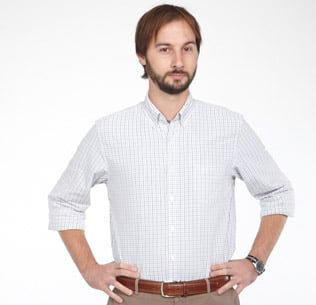In a basement on the University of Maryland campus is the lab where physicist Chris Monroe achieved the seemingly impossible.
Under fluorescent lights, with bundles of wires descending from the ceiling, Monroe and his team of five worked for months on an experiment that sounds like science fiction. They were able to make the information from an atom move from one vacuum chamber to another chamber a few meters away. The atom’s information didn’t travel through wires or air. It just leaped.
Monroe’s experiment was the first ever to teleport information between matter separated by a large distance, and it earned his team at Maryland’s Joint Quantum Institute accolades and a spot on Time’s list of 2009’s best inventions.
An unassuming 44-year-old who dresses in jeans, Monroe gives the impression of a man devoted to his work for the enjoyment of it. He shrugs off talk of his research’s ramifications; his interest is the here and now of quantum mechanics. It’s science for science’s sake.
Yet his breakthrough could have important applications. Among them: a new mode of electronic communication that would result in ultra-secure computers capable of working at speeds almost unimaginable today and able to make calculations far too complex for current technology. Says Monroe’s colleague, Nobel Prize–winning physicist Bill Phillips: “It’s a new scientific revolution for the 21st century.”
Since its inception in 2006, the Joint Quantum Institute has explored the world of quantum mechanics, where something can exist in two places at once and where the mere act of observing something causes it to change.
Quantum physicists study the sometimes bewildering behavior of atoms and the subatomic particles within them. “At such small scales, exotic circumstances begin to emerge,” Monroe says.
Practical applications have long eluded physicists. For the last century, most were just trying to figure out what quantum mechanics was. Niels Bohr—who won the 1922 Nobel for his work in the field—once said: “Anyone who is not shocked by quantum theory has not understood it.” Albert Einstein spent years trying to prove that many principles of quantum theory were bogus, although he himself made significant contributions to the field. Today Phillips says of Monroe, “There he is, the man who proves Einstein wrong every day.”
Talk to physicists at the institute about their research and you’ll often hear the word “weird.” It’s Phillips’s term for the aspects of quantum mechanics that can be studied, measured, and demonstrated yet remain mysteries in their disregard for the normal rules of the universe.
“We have an impression of the way things work on the macroscopic level,” Phillips says, drawing a complex equation on a chalkboard. “However, it is not necessarily true that they work that way on the atomic level.”
One phenomenon is called superposition. It essentially means something can be in two places simultaneously.
“One of the key features of our ordinary experience is that something cannot be in two places at the same time,” says Phillips. “It’s almost a proverb: ‘Oh, I’m sorry, I can’t be in two places at once.’ Quantum mechanics says you can.”
He says there are measurements physicists use to show how electrons—particles that normally spin either up or down—have the habit of doing both simultaneously within an atom. “We understand the mathematics of how this happens,” he says. “We just don’t understand intuitively how something can behave that way.”
Whereas Phillips writes equations to explain superposition, Monroe draws analogies.
“I compare it to the beauty of waves,” Monroe says. “When you look out to sea, you don’t think of the pieces of the waves. They are in a natural state of superposition, existing all at once, everywhere.”
Read the rest of this story in the June issue of Washingtonian, on newsstands now.


















